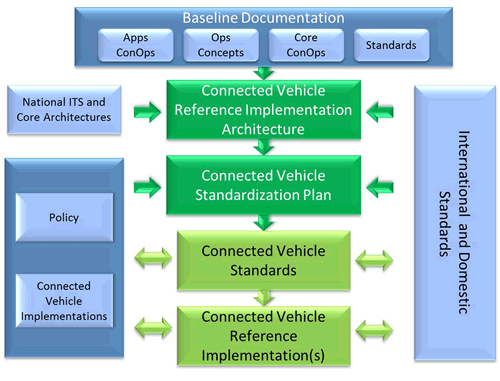Approach
The following graphic illustrates the approach taken to develop the Connected Vehicle Reference Implementation Architecture (CVRIA).

Inputs to the Architecture:
 A number of source documents were used as the baseline including Concepts of Operation (ConOps) documents from connected vehicle applications, Operational Concepts, the Core System ConOps, and existing standards. The existing National ITS Architecture and the Core System architecture were also used as inputs along with the existing International and Domestic standards.
A number of source documents were used as the baseline including Concepts of Operation (ConOps) documents from connected vehicle applications, Operational Concepts, the Core System ConOps, and existing standards. The existing National ITS Architecture and the Core System architecture were also used as inputs along with the existing International and Domestic standards.
Applications and supporting functionality were identified based on the various research activities underway and completed as part of the Research and Innovative Technology Administration's (RITA) connected vehicle research program. Primary sources of application concepts and needs were:
- Vehicle-to-vehicle (V2V) safety applications documented in the Vehicle Safety Communications – Applications (VSC-A) Final Report
- Vehicle-to-infrastructure (V2I) safety applications documented in various V2I Concepts of Operations produced for USDOT
- Mobility applications documented in the Concepts of Operations developed under the Dynamic Mobility Applications (DMA) program
- Environmental applications documented as part of the AERIS and Road Weather programs
- Supporting functions described as part of the Core System systems engineering work, as well as the Security Credentials Management System (SCMS) implemented for the Model Deployment Safety Pilot
- Various other safety, mobility and environmental applications considered as part of the J2735 Systems Engineering draft
Needs and requirements, if they were available in the source documents, were captured as inputs to the CVRIA. In some cases, needs or requirements may not have been developed but important concepts and interfaces may have been identified in that source. In those cases Needs and/or Requirements were derived in order to support the architecture development. See the requirements tab on the application pages to see the Needs and Requirements for each of the connected vehicle applications.
Components of the Architecture:
As connected vehicle research continues at various levels it was recognized that there needs to be a framework from which all of the potential interfaces can be identified and analyzed as potential candidates for standardization. Because there are so many types of applications and underlying system definitions an approach was defined to develop a System Architecture based on the fundamentals of ISO/IEC/IEEE 42010:2011, a standard for "Systems and software engineering — Architecture description." This includes steps to define, not just data and messages, but the full environment in which the stakeholder concerns are satisfied – this includes understanding the functionality, the high-level physical partitioning that may be required or that may be supported as alternative configurations, the enterprise or institutional relationships that will govern how those systems are deployed and used, and the communications protocols that are necessary for those interfaces to work. An architecture like this becomes a 'framework' for developers, standards organizations, and implementers to all use as a common frame of reference for developing the eventual systems. Refer to the Viewpoints page for a more complete description of the 4 architecture viewpoints.
Applying the Architecture:
 Once this multi-faceted architecture is developed the interfaces will be defined and analyzed to see what areas need to be standardized. Some interfaces may already be standardized, others may just need some modification to accommodate a new interface or concept, or some interfaces may not be standardized at all. A Standards Plan will be developed with DOT and the stakeholder community to establish the priorities for standardizing these interfaces.
Once this multi-faceted architecture is developed the interfaces will be defined and analyzed to see what areas need to be standardized. Some interfaces may already be standardized, others may just need some modification to accommodate a new interface or concept, or some interfaces may not be standardized at all. A Standards Plan will be developed with DOT and the stakeholder community to establish the priorities for standardizing these interfaces.
Eventually, reference implementations based on those new/modified standards can be established which will inform the policy makers, implementers, as well as the international community.
CVRIA Maintenance
 As new applications are conceived and as the interfaces are standardized and systems get deployed the lessons learned from those projects will be fed back into the CVRIA to ensure that the connected vehicle environment is able to evolve and grow gracefully.
As new applications are conceived and as the interfaces are standardized and systems get deployed the lessons learned from those projects will be fed back into the CVRIA to ensure that the connected vehicle environment is able to evolve and grow gracefully.
Once the CVRIA has been developed and established as a reference then it will be incorporated, as appropriate, into the National ITS Architecture – the framework for all of ITS so that the interfaces and systems can be implemented in a consistent fashion alongside traditional ITS projects.
Stakeholder Input
 Note the numerous opportunities for feedback as the architecture products are developed and the standards plan is compiled. Watch for workshops and webinars on this subject to stay engaged. Use the Contact Us page to provide your thoughts and comments.
Note the numerous opportunities for feedback as the architecture products are developed and the standards plan is compiled. Watch for workshops and webinars on this subject to stay engaged. Use the Contact Us page to provide your thoughts and comments.